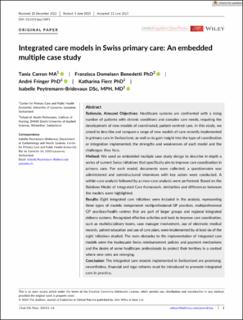Please use this identifier to cite or link to this item:
https://doi.org/10.21256/zhaw-28284Full metadata record
| DC Field | Value | Language |
|---|---|---|
| dc.contributor.author | Carron, Tania | - |
| dc.contributor.author | Domeisen Benedetti, Franzisca | - |
| dc.contributor.author | Fringer, André | - |
| dc.contributor.author | Fierz, Katharina | - |
| dc.contributor.author | Peytremann-Bridevaux, Isabelle | - |
| dc.date.accessioned | 2023-07-20T13:52:15Z | - |
| dc.date.available | 2023-07-20T13:52:15Z | - |
| dc.date.issued | 2023-07-10 | - |
| dc.identifier.issn | 1356-1294 | de_CH |
| dc.identifier.issn | 1365-2753 | de_CH |
| dc.identifier.uri | https://digitalcollection.zhaw.ch/handle/11475/28284 | - |
| dc.description.abstract | Rationale, Aimsand Objectives: Healthcare systems are confronted with a rising number of patients with chronic conditions and complex care needs, requiring the development of new models of coordinated, patient-centred care. In this study, we aimed to describe and compare a range of new models of care recently implemented in primary care in Switzerland, as well as to gain insight into the type of coordination or integration implemented, the strengths and weaknesses of each model and the challenges they face. Method: We used an embedded multiple case study design to describe in-depth a series of current Swiss initiatives that specifically aim to improve care coordination in primary care. For each model, documents were collected, a questionnaire was administered and semistructured interviews with key actors were conducted. A within-case analysis followed by a cross-case analysis were performed. Based on the Rainbow Model of Integrated Care framework, similarities and differences between the models were highlighted. Results: Eight integrated care initiatives were included in the analysis, representing three types of models: independent multiprofessional GP practices, multiprofessional GP practices/health centres that are part of larger groups and regional integrated delivery systems. Recognized effective activities and tools to improve care coordination, such as multidisciplinary teams, case manager involvement, use of electronic medical records, patient education and use of care plans, were implemented by at least six of the eight initiatives studied. The main obstacles to the implementation of integrated care models were the inadequate Swiss reimbursement policies and payment mechanisms and the desire of some healthcare professionals to protect their territory in a context where new roles are emerging. Conclusion: The integrated care models implemented in Switzerland are promising; nevertheless, financial and legal reforms must be introduced to promote integrated care in practice. | de_CH |
| dc.language.iso | en | de_CH |
| dc.publisher | Wiley | de_CH |
| dc.relation.ispartof | Journal of Evaluation in Clinical Practice | de_CH |
| dc.rights | http://creativecommons.org/licenses/by/4.0/ | de_CH |
| dc.subject | Switzerland | de_CH |
| dc.subject | Delivery of healthcare | de_CH |
| dc.subject | Integrated | de_CH |
| dc.subject | Intersectoral collaboration | de_CH |
| dc.subject | Organizational case study | de_CH |
| dc.subject | Patient care management | de_CH |
| dc.subject | Primary healthcare | de_CH |
| dc.subject.ddc | 362: Gesundheits- und Sozialdienste | de_CH |
| dc.title | Integrated care models in Swiss primary care : an embedded multiple case study | de_CH |
| dc.type | Beitrag in wissenschaftlicher Zeitschrift | de_CH |
| dcterms.type | Text | de_CH |
| zhaw.departement | Gesundheit | de_CH |
| zhaw.organisationalunit | Institut für Pflege (IPF) | de_CH |
| dc.identifier.doi | 10.1111/jep.13891 | de_CH |
| dc.identifier.doi | 10.21256/zhaw-28284 | - |
| dc.identifier.pmid | 37427549 | de_CH |
| zhaw.funding.eu | No | de_CH |
| zhaw.issue | 6 | de_CH |
| zhaw.originated.zhaw | Yes | de_CH |
| zhaw.pages.end | 1038 | de_CH |
| zhaw.pages.start | 1025 | de_CH |
| zhaw.publication.status | publishedVersion | de_CH |
| zhaw.volume | 29 | de_CH |
| zhaw.publication.review | Peer review (Publikation) | de_CH |
| zhaw.author.additional | No | de_CH |
| zhaw.display.portrait | Yes | de_CH |
| Appears in collections: | Publikationen Gesundheit | |
Files in This Item:
| File | Description | Size | Format | |
|---|---|---|---|---|
| 2023_Carron-etal_Integrated-care-models-Swiss-primary-care.pdf | 1.64 MB | Adobe PDF |  View/Open |
Show simple item record
Carron, T., Domeisen Benedetti, F., Fringer, A., Fierz, K., & Peytremann-Bridevaux, I. (2023). Integrated care models in Swiss primary care : an embedded multiple case study. Journal of Evaluation in Clinical Practice, 29(6), 1025–1038. https://doi.org/10.1111/jep.13891
Carron, T. et al. (2023) ‘Integrated care models in Swiss primary care : an embedded multiple case study’, Journal of Evaluation in Clinical Practice, 29(6), pp. 1025–1038. Available at: https://doi.org/10.1111/jep.13891.
T. Carron, F. Domeisen Benedetti, A. Fringer, K. Fierz, and I. Peytremann-Bridevaux, “Integrated care models in Swiss primary care : an embedded multiple case study,” Journal of Evaluation in Clinical Practice, vol. 29, no. 6, pp. 1025–1038, Jul. 2023, doi: 10.1111/jep.13891.
CARRON, Tania, Franzisca DOMEISEN BENEDETTI, André FRINGER, Katharina FIERZ und Isabelle PEYTREMANN-BRIDEVAUX, 2023. Integrated care models in Swiss primary care : an embedded multiple case study. Journal of Evaluation in Clinical Practice. 10 Juli 2023. Bd. 29, Nr. 6, S. 1025–1038. DOI 10.1111/jep.13891
Carron, Tania, Franzisca Domeisen Benedetti, André Fringer, Katharina Fierz, and Isabelle Peytremann-Bridevaux. 2023. “Integrated Care Models in Swiss Primary Care : An Embedded Multiple Case Study.” Journal of Evaluation in Clinical Practice 29 (6): 1025–38. https://doi.org/10.1111/jep.13891.
Carron, Tania, et al. “Integrated Care Models in Swiss Primary Care : An Embedded Multiple Case Study.” Journal of Evaluation in Clinical Practice, vol. 29, no. 6, July 2023, pp. 1025–38, https://doi.org/10.1111/jep.13891.
Items in DSpace are protected by copyright, with all rights reserved, unless otherwise indicated.